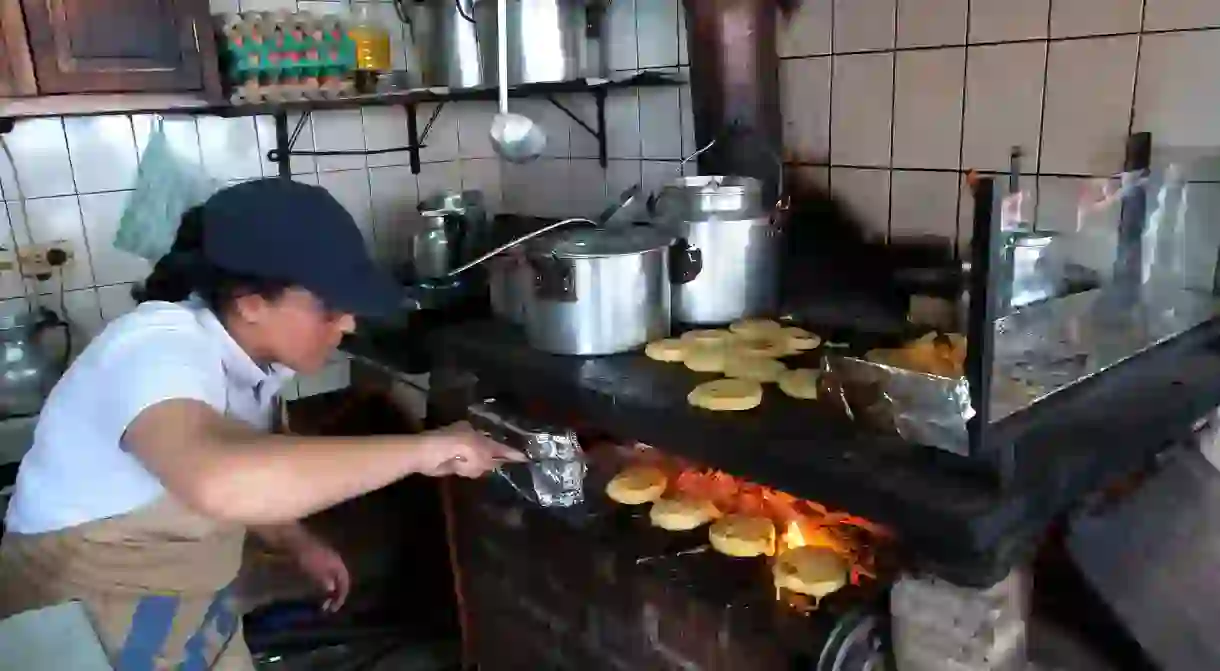7 Traditional Colombian Breakfasts You Must Try

If there’s a mealtime Colombians know how to do properly, it’s breakfast. Considered the best time of day to fill up, you won’t be seeing any dainty croissants or açaí bowls on the menu here. From poached-egg soups to tamales steamed in plantain leaves, here are seven hearty Colombian breakfasts you can’t leave without trying.
Arepas
Eaten at any time of day, and with almost any accompaniment you can think of, arepas are Colombia’s favorite, and most versatile, culinary staple. Often described as a kind of corn cake, an arepa is made with ground white or yellow corn and usually fried or grilled on an open fire. Depending on where you are in the country, you’ll find different versions – some deep-fried and served with eggs, beef and chicharrón (fried pork), and others grilled or baked and drenched in sugar, butter and melted cheese or chocolate. Your mission? To try them all.

Bandeja paisa
If you’ve woken up particularly hungry, then the bandeja paisa is what you’ll want. Akin to the full English breakfast, this king-size feast is an entire tray stacked with chorizo, red beans, ground meat, chicharrón, rice, a fried egg, plantains, arepas, avocado and black pudding. The bandeja paisa was born in the Paisa region of Colombia (hence the name), which means it is most commonly served in the departments of Antioquia, Caldas, Risaralda and Quindío.

Changua
The ultimate comfort breakfast is changua – a creamy soup made with milk, poached eggs and scallions. While every region puts its own spin on it, a bowl of changua usually comes topped with cilantro, home-made croutons and a side of almojábanas, oven-baked cheese rolls perfect for wiping the bowl clean. A warming start to the day, this dish is a popular breakfast in Colombia’s chilly Andean cities and towns.

Tamales
Tamales vary from region to region and even from town to town in Colombia, with hundreds of different variations – from round and doughy to flat and crumbly. The rule of thumb, however, is that they’re usually made by stuffing packages of corn or rice dough with meat and vegetables and then steaming them for several hours in thick plantain leaves. You’ll find these in restaurants and street-food stands all over the country, but Bogotá has earned itself something of a reputation when it comes to Colombia’s tastiest tamales.

Calentado
Meaning ‘the heated dish,’ the calentado started as a way for coffee farmers to reuse the leftovers from the night before – all they needed to do was ‘heat up’ the food. Today, the calentado – a huge bowl of rice, red beans, eggs and plantains served with an arepa – is made fresh to order in almost every restaurant in the coffee region and Antioquia.

Aguapanela con queso
Perhaps one of Colombia’s most unusual food combinations, aguapanela con queso is a very sweet sugarcane drink served piping hot with a slice of queso fresco (fresh soft cheese that is often quite salty) and, depending on the region, either some plantains, arepas or cheesy almojábanas. Tradition has it that you submerge the cheese into the hot aguapanela until it melts, giving the drink a gooey, thick consistency and a sweet-salty taste. The same applies to hot chocolate and coffee, which is also served with a slice of cheese, particularly in Colombia’s coffee region. It sounds really wrong, but it (kind of) works.
Caldo de costilla
Had a big night on the town? Order a caldo de costilla. Sworn by Colombians to be the best hangover cure, this beef rib, carrot, potato, garlic and cilantro broth is often served to flailing partygoers on their way out of a bar in the early hours of the morning. A hearty, warming soup, the caldo is most commonly served in the colder regions of Bogotá, Cundinamarca and Boyacá.













